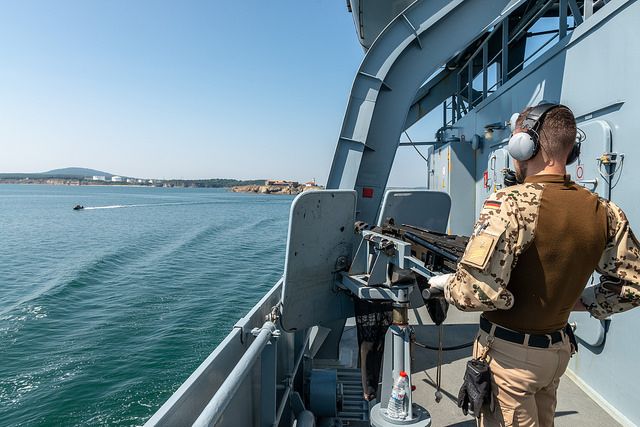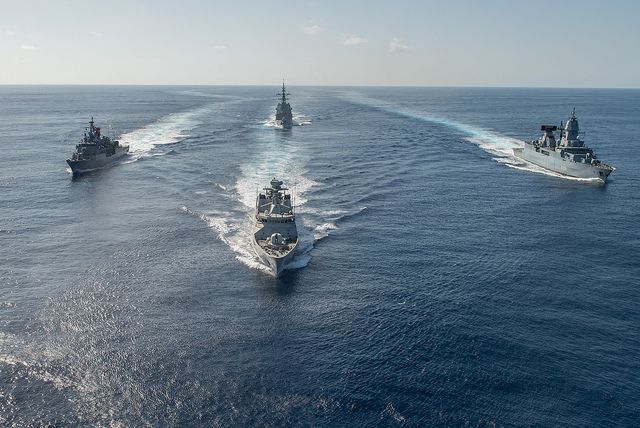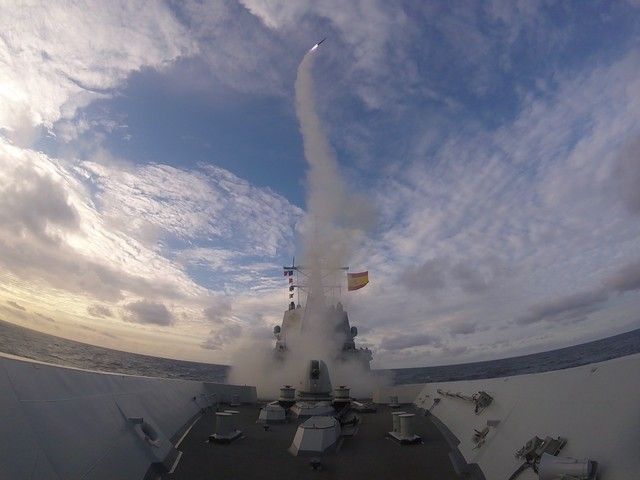A German Perspective
Despite all UN-resolutions a never ending series of North-Korean missile tests are putting the world in unrest. Media-effective reports and provocative performance displays, together with a regime that is obviously ready for anything, are justifying the question of possible and appropriate prevention. The USA as the protective power of the region, meanwhile themselves within the effective range of these long-range ballistic missiles, are feeling challenged. The situation in the North Pacific seems to further escalate.
The geographic distance of North Korea from Central Europe and its allies is great, but if these weapons that are undoubtedly existent also elsewhere, get into the wrong hands at the south-eastern periphery of the Mediterranean Sea or in the Middle East, then the call for concerned precautionary measures would suddenly be omnipresent. Consequently, provisions with respect to an effective Ballistic Missile Defence (BMD) that is based in Europe or respectively on board and this way easy to redeploy, are no vague futuristic project, but part of a responsible security precaution.
Threat Development and Perception
Already in the last German Defence Political Guidelines effective early-warning- and defence measures for the protection of the population against the increasing threat from ballistic missiles with a mass destruction potential was described as necessary. The rationale for a BMD-precaution is explicitly given with the proliferation and further distribution of Weapons of Mass Destruction (WMD) and the continued improvement of carrier systems, which can, with extended ranges or with respective dislocations, become a threat also to Central and Western Europe.
The Mediterranean Sea, in particular, has become a center of gravity and special area of interest due to the number of conflicts in that region and adjacent areas; the more frequent missions of the German Navy in that region confirms this. Meanwhile, a number of states grouped around the eastern Mediterranean and its adjoining regions can dispose of ballistic missiles. Their further modernisation and the technological progress with extended ranges make threats from farer distant regions increasingly possible.
In this context, the sheer number of publications and decisions regarding the necessity of a European contribution to BMD highlight a broad European consensus on the matter; however, the initiation of concrete measures by the same European allies is apparently met with a certain degree of caution due to limited defence budgets and the hitherto perceived readiness of the US to defend Europe if necessary. Currently US contribution to the NATO BMD structure in Europe includes AEGIS-ships in Rota, Spain, mobile sensor AN-TPY-2 and the installation of two land-based AEGIS-systems in Poland and Romania with SM-3 Block IIa. No European navy that has comparable capabilities to act in a complementing role in the region.
But with the new US administration, European allies may have to reconsider US support to the region. In part, this is due to a potential shift in focus from Europe to the Asia-Pacific region, where tensions with Pyongyang and Beijing are calling for more assets and presence in regional waters. At NATO level, Washington has also been calling for more financial involvement from strong economic nations such as Germany to make the institution’s financial burden more equitable. Any decrease in US support to the region could, however, have significant consequence.

National Contribution to the Integrated Air Defence
While the German Air Force is well equipped in the lower layer or lower tier (US terminology) intercept level, the German Armed Forces (Bundeswehr) cannot contribute directly to the defence against medium- or long-range ballistic missiles outside the atmosphere with corresponding effectors. The protection of Germany or of an ally against such a threat is foreseeably dependent on the preparedness of the US to provide resources for the European Phased Adaptive Approach (EPAA).
Nevertheless, if required, the German Navy can contribute at sea with F-124 and Standard Missile 2 (SM-2) for unit protection or as goalkeeper of the US AEGIS ships, a tactic that was successfully demonstrated in former Cooperative Deployments with US carrier battle groups. With the obsolescence elimination SMART-L and the F-124 Capability Enhancement (for which replacements have no yet been chosen, although the SMART L ELR could be an option) it will also on the medium-term be able to provide a substantial sensor contribution for early warning and target pre-assignment against ballistic missiles in the upper layer.
However, judging from the pace of current developments, the capability to act as BMD spotter would be available in five to six years at the earliest (first F-124 modified with the SMART L replacement), while the capability to effect (F-124 or successor as shooter) against ballistic missiles outside the atmosphere was up to now not yet actively addressed or pursued as a concrete armament project. Here, clear directives from the political leadership are missing. Even in case of expeditious positive decision-making, this capability would not be achievable before the middle of the 2020s.

Background and Decisions
International conflict prevention and crisis management are no longer the predominant scale for determining Armed Forces’ capability portfolios. The requirement to appropriately counter a ballistic missile threat is now also a seminal factor, as explicitly underlined by the Heads of States and Governments at the 2016 NATO Summit in Warsaw. As such, it has become crucial for European NATO allies to ensure that they have the BMD capabilities crucial to defend themselves.
Already at the Lisbon NATO-Summit in the year 2010 it was decided to build up a “Missile Defence” for the whole NATO alliance territory (NATO BMD) and, since the 2012 follow-up summit in Chicago, NATO has been running the BMD Operation Centre (BMDOC) in Ramstein. Germany is providing infrastructure and expertise. Other nations are also contributing voluntarily with the stationing of sensors or intercept missiles for the lower layer (PATRIOT). The US, however, is the only nation to contribute with regards to the upper layer in the framework of the EPAA, and at present it appears that it is in this layer, that is, outside the atmosphere and before the release of multiple warheads, that ballistic missiles can be countered most effectively.
At the 2014 NATO Summit in Wales, Germany above all favoured the Framework Nations Concept (FNC), which focuses on different clusters where individual nations and services take up the initiative and bear the main burden, or provide the framework, for the delivery and build-up of certain capabilities. Since April 2015, the German Navy has taken up the leadership in the sub-cluster ‘Upper Layer BMD’ inside the clusters ‘Air & Missile Defence’ (AMD), which is, altogether, coordinated by the German Air Force. Sub-cluster cooperation partners include Denmark, the Netherlands and Belgium.
Furthermore, during the ‘At Sea Demo 2015’, which was planned and directed by the Maritime Theatre Missile Defence Forum (MTMD-F) and which followed a German-Dutch operational concept, units from eight nations have tested for the first time in European waters a coordinated air defence and BMD against targets also in the upper layer. Germany participated with a number of field grade officers, and the German Navy manned the Chief of Staff position.
Finally, in May 2017, Germany has taken over from the Netherlands for one year the direction of the MTMD-F, the only forum that is dealing professionally with the subject maritime AMD. During last autumn, with FORMIDABLE SHIELD 2017 (FS 17) another sea-based BMD exercise has taken place in the area of the northern flank, again with corresponding German design and participation.

As such, over the past decades the German Navy has been actively contributing to the development of the sea-based BMD, is represented in relevant international panels and conferences, and supports in principal not only the sensor- but in the long term also the effector-part of building up a maritime European BMD capability.
Long Road Ahead
Altogether, there are a number of activities, concepts and decisions that underline the necessity of BMD – also and explicitly sea-based. NATO planning objectives include the build-up of BMD capabilities under the principle of burden sharing. The German Navy is participating significantly in conceptual and tactical developments in the area of sea based BMD, and with the Dutch SMART L ELR on ADCF-frigates from 2018/2019 – later after a sensor upgrade also on F-124 – there will be for the first time self-reliant European sensor capabilities available for the acquisition of ballistic missiles in the upper intercept layer.
However, the road to a fully self-reliant European BMD system remains long. Because of the expected cost implications and the threat spectrum one should cooperate from the outset with selected European partners who already have especially designed anti air warfare frigates with the respective sensor technology and upgrade possibilities to become a shooter or will have them in the foreseeable future. In fact, with the Standard Missile 3 there would be already an intercept missile for the upper layer, which over many years has convincingly proven its functional and operational capability in now over 30 test firings at and from sea.
A number of questions also linger. For instance, the technical solution to implement a shooter equipment aboard to be able to shoot SM-3 has to be investigated; so far the F-124 is only able to fire the much smaller SM-2 in order to provide force protection (adapt the vertical launch system).
Could European nations start with the leasing of intercept missiles? Or could it be worth considering the establishment of a smaller European Missile Pool, which could be used in common with the USN?
With partners like the Netherlands, and Belgium, but also with Denmark, Norway and Spain as well as the four BMD-ships of the US-Navy, up to four positions in the Mediterranean Sea could be permanently occupied, if these navies could ensure a minimum detachment of one BMD-frigate per nation. If not a smaller couple of European navies may take over the BMD duties with two or three ships each. Keeping the amount of missions and operations in mind the reasonable minimal European contribution could comprise half a dozen ships that are equipped for the BMD-shooter role. Together with the American AEGIS destroyers, one could maintain if required a permanent presence of up to four shooters in the Mediterranean area with a common stock of intercept missiles, while respecting a rotation cycle of mission, maintenance and mission preparation.
Immediate actions and further steps should be considered to achieve a foreseeable and feasible solution until the turn of the next decade.
Rear Admiral Jürgen Mannhardt (retd) has served aboard fast patrol boats, destroyers and frigates in various positions up to deputy & chief of staff DEU Flotilla 1. Before he retired he was director for the plans & policy division in the German Navy HQ and responsible for naval staff talks & international cooperationup to deputy and chief of staff DEU Flotilla 1. Today he consults on defence matters a number of German and international companies. This article was originally published in NAVAL FORCES II/2018.
























